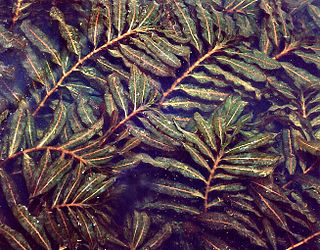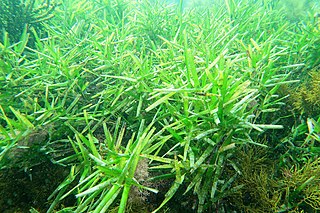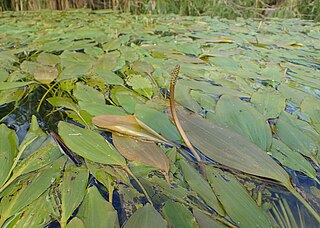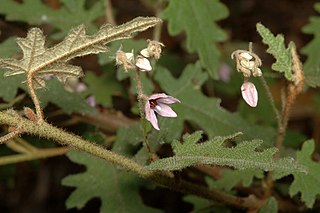
Cephalotus is a genus which contains one species, Cephalotus follicularis the Albany pitcher plant, a small carnivorous pitcher plant. The pit-fall traps of the modified leaves have inspired the common names for this plant, which include 'Albany pitcher plant", "Western Australian pitcher plant", "Australian pitcher plant", or "fly-catcher plant." It is an evergreen herb that is endemic to peaty swamps in the southwestern corner of Western Australia.

The Potamogetonaceae, commonly referred to as the pondweed family, is an aquatic family of monocotyledonous flowering plants. The roughly 110 known species are divided over six genera. The largest genus in the family by far is Potamogeton, which contains about 100 species.

Potamogeton is a genus of aquatic, mostly freshwater, plants of the family Potamogetonaceae. Most are known by the common name pondweed, although many unrelated plants may be called pondweed, such as Canadian pondweed. The genus name means "river neighbor", originating from the Greek potamos (river) and geiton (neighbor).

Potamogeton crispus, the crisp-leaved pondweed, curly pondweed, curly-leaf pondweed or curled pondweed, is a species of aquatic plant (hydrophyte) native to Eurasia but an introduced species and often a noxious weed in North America.

Amphibolis griffithii is a seagrass found in waters along the southwestern coasts of Western Australia, extending to Encounter Bay in South Australia.
Posidonia robertsoniae is one of the seagrasses of Western Australia, submerged flowering plants that occur in the southern coastal waters.
Patersonia maxwellii is a species of flowering plant in the iris family Iridaceae and is endemic to the south of Western Australia. It is a tufted, rhizome-forming perennial herb with linear leaves and violet tepals.

Potamogeton polygonifolius or bog pondweed, is an aquatic plant. It is found in shallow, nutrient-poor, usually acid standing or running water, bogs, fens and occasionally ditches.

Potamogeton coloratus, the fen pondweed, is an aquatic plant in the genus Potamogeton. It is found in shallow peaty calcareous lakes, ponds and ditches, commonly associated with lowland fens.

Potamogeton alpinus is a species of perennial aquatic plant known by the common names alpine pondweed and red pondweed. It is widespread in the northern hemisphere in both rivers and lakes with good water quality.

Potamogeton diversifolius is a species of aquatic plant known by the common names waterthread pondweed and diverse-leaved pondweed. It is native to most of the United States, as well as sections of southwestern Canada, and northern Mexico, where it grows in water bodies such as ponds, lakes, ditches, and slow-moving streams. This is a perennial herb producing a very narrow, compressed stem branching to a maximum length around 35 centimeters. It has thin, pointed linear leaves a few centimeters long spirally arranged about the thin stem. The inflorescence is a small spike of flowers emerging from the water surface. Inflorescences also grow on submersed sections of the stem; these are smaller and spherical. It can be difficult to distinguish from similar species of pondweed.

Potamogeton epihydrus is a perennial aquatic plant known by the common names ribbonleaf pondweed and Nuttall's pondweed, and American pondweed in the United Kingdom. It is native to much of North America, where it grows in water bodies such as ponds, lakes, ditches, and slow-moving streams.

Potamogeton gramineus is a species of aquatic plant known by the common name various-leaved pondweed, variableleaf pondweed, grass-leaved pondweed or grassy pondweed, native to the northern hemisphere where it grows in shallow, clean water.

Potamogeton nodosus is a species of aquatic plant known by the common names longleaf pondweed and Loddon pondweed. It is native to Eurasia and the Americas, where it is widespread and can be found in water bodies such as ponds, lakes, ditches, and streams. This is a perennial herb producing a thin, branching stem easily exceeding a meter in maximum length. The leaves are linear to widely lance-shaped and up to 15 centimeters long by 4 wide. Both floating leaves and submerged leaves are borne on long petioles, a distinguishing characteristic. The inflorescence is a spike of many small flowers arising from the water on a peduncle.

Nymphaea gigantea, commonly known as the giant waterlily or blue waterlily, is a perennial, herbaceous plant in the family Nymphaeaceae which is native to parts of northern and eastern Australia, and it has been widely cultivated elsewhere. It is an aquatic plant whose natural habitat is permanent and semi-permanent still water bodies

Scaevola repens is a shrub in the family Goodeniaceae, endemic to the south west of Western Australia.

Dampiera dentata is a plant in the family Goodeniaceae, native to Western Australia and the Northern Territory.

Goodenia arthrotricha is a species of flowering plant in the family Goodeniaceae and endemic to south-western Western Australia. It is an erect perennial, herb with linear to lance-shaped leaves with the narrower end towards the base, racemes of blue flowers with linear bracteoles at the base, and oval fruit.

Lechenaultia longiloba, commonly named Irwin leschenaultia, is a species of flowering plant in the family Goodeniaceae and is endemic to the south-west of Western Australia. It is a straggling, low-lying herb or subshrub with narrow, rather fleshy leaves, and pale yellow or green petals with deep pink or red wings.

Lasiopetalum pterocarpum, commonly known as wing-fruited lasiopetalum, is a species of flowering plant in the family Malvaceae and is endemic to a restricted area in the south-west of Western Australia. It is an open shrub with many densely hairy stems, egg-shaped and lobed leaves and pink and dark red flowers.

















